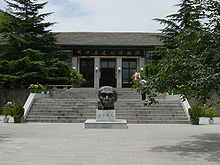Zhoukoudian
| Situs Warisan Dunia UNESCO | |
|---|---|
 | |
| Kriteria | Kultural: iii, vi |
| Nomor identifikasi | 449 |
| Pengukuhan | 1987 (ke-11) |
| Zhoukoudian | |||||||
|---|---|---|---|---|---|---|---|
| Hanzi: | 周口店 | ||||||
| |||||||
Zhoukoudian atau Choukoutien (周口店) adalah sebuah sistem gua di Beijing, Tiongkok. Ada banyak penemuan arkeologis di tempat ini, termasuk salah satu spesies pertama Homo erectus, dijuluki Manusia Peking, dan sekumpulan tulang yang bagus dari hyena raksasa Pachycrocuta brevirostris.
Masa ketika Manusia Peking menghuni situs ini sangat bervariasi, antara 700.000-200.000 tahun yang lalu,[1] 670.000-470.000 tahun yang lalu,[2] dan tidak lebih awal dari 530.000 tahun yang lalu.[3]
Situs Manusia Peking pertama kali ditemukan oleh Johan Gunnar Andersson pada tahun 1921[4] dan pertama kali digali oleh Otto Zdansky pada tahun 1921 dan 1923 menemukan dua gigi manusia.[5] Penemuan ini kemudian diidentifikasi oleh Davidson Black sebagai milik spesies yang tidak diketahui sebelumnya dan disusul dengan penggalian ekstensif.
Celah di tengah batu gamping mengandung sedimen Pleistosen Tengah telah menghasilkan fosil sekitar 45 individu beserta hewan, serpihan batu, dan perkakas potong.
Fosil hewan tertua berasal dari masa paling awal 690.000 tahun yang lalu dan perkakas berasal dari masa 670.000 tahun yang lalu[6] sementara otoritas lain menyatakan perkakas yang ditemukan berasal dari masa tidak lebih awal dari 530.000 tahun yang lalu.[3]
Selama Paleolikum Akhir, situs ini dihuni kembali dan fosil Homo sapiens beserta batu dan perkakas tulangnya juga telah ditemukan kembali dari Gua Atas.
Gua-gua ini terletak di Distrik Fangshan (房山区), sebelah barat daya dari pusat kota Beijing.
Sejarah Penggalian[sunting | sunting sumber]

Geolog Swedia, Johan Gunnar Andersson pertama kali memulai eksplorasinya pada tahun 1918 di sebuah daerah yang disebut Bukit Tulang Ayam oleh penduduk setempat yang telah salah mengidentifikasi fosil hewan pengerat yang berlimpah di sana,[7] namun tidak sampai tahun 1921, dia dan paleontolog Amerika, Walter W. Granger dipimpin ke situs yang dikenal sebagai Bukit Tulang Naga oleh orang-orang tambang lokal. Melihat kuarsa putih yang asing di daerah tersebut, dia segera menyadari bahwa tempat tersebut akan menjadi tempat yang baik untuk mencari sisa-sisa manusia primitif.[8]
Referensi[sunting | sunting sumber]
- ^ "UNESCO World Heritage Site: Peking Man Site at Zhoukoudian" http://whc.unesco.org/en/list/449 retrieved 12/15/2013
- ^ Climatic cycles investigated by sediment analysis in Peking Man’s Cave, Zhoukoudian, China., Zhou, C., Lui, Z., Wang, Y.; Journal of Archaeological Science 27, 2000, pp 101-109
- ^ a b Encyclopedia of Prehistory: Volume 3: East Asia and Oceania, Chuan Kun Ho; Human Relations Area Files, Inc., 2001, p 352
- ^ "The First Knock at the Door". Peking Man Site Museum.
In the summer of 1921, Dr. J.G. Andersson and his companions discovered this richly fossiliferous deposit through the local quarry men's guide. During examination he was surprised to notice some fragments of white quartz in tabus, a mineral normally foreign in that locality. The significance of this occurrence immediately suggested itself to him and turning to his companions, he exclaimed dramatically "Here is primitive man, now all we have to do is find him!"
- ^ "The First Knock at the Door". Peking Man Site Museum.
For some weeks in this summer and a longer period in 1923 Dr. Otto Zdansky carried on excavations of this cave site. He accumulated an extensive collection of fossil material, including two Homo erectus teeth that were recognized in 1926. So, the cave home of Peking Man was opened to the world.
- ^ "Middle Pleistocene climate and habitat change at Zhoukoudian, China, from the carbon and oxygen isotopic record from herbivore tooth enamel", Gaboardia, Deng and Wang, Quaternary Research 63, 2005, p 331
- ^ "The Peking Man World Heritage Site at Zhoukoudian". UNESCO. Diakses tanggal 2008-04-20.
In February 1918, Johann Gunnar Andersson, a famous Swedish geologist and archaeologist, was told that there were some fossils at what was called Chicken-bone Hill near Zhoukoudian. He was then serving as an adviser on mineral affairs in the Ministry of Agriculture and Commerce of the Chinese Government. He showed much interest and, in the following month, made a survey at the hill where a lot of rodent fossil was collected. The rodent fossil was taken as chicken bones by local people and the Chicken-bone Hill was so named. The latter is nominated later as Locality 6 of the Peking Man Site. This discovery of the locality is not so important, but the survey led to a series of investigations in the region.
- ^ "Review of the History". Peking Man Site Museum.
John Gunnar Anderson, a Swedish geologist, discovered Peking Man Site in 1921. Under his supervision, Otto Zdensky, an Austrian palaeontologist, excavated at the site in 1921 and 1923 and found a human molar.
